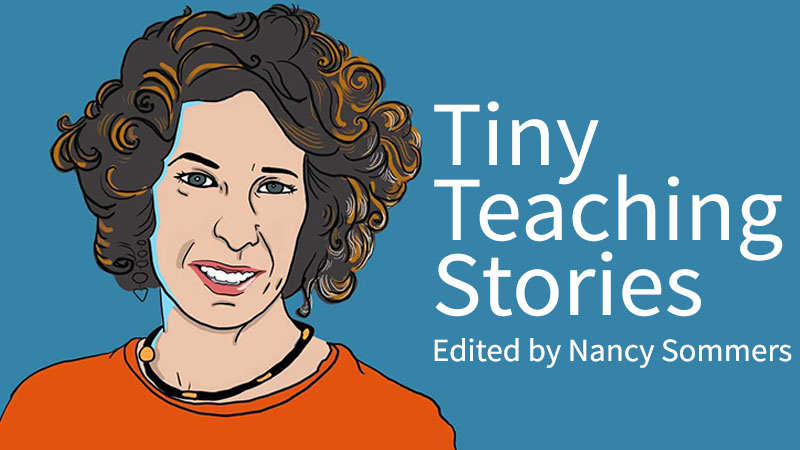-
About
Our Story
back- Our Mission
- Our Leadershio
- Accessibility
- Careers
- Diversity, Equity, Inclusion
- Learning Science
- Sustainability
Our Solutions
back
-
Community
Community
back- Newsroom
- Discussions
- Webinars on Demand
- Digital Community
- The Institute at Macmillan Learning
- English Community
- Psychology Community
- History Community
- Communication Community
- College Success Community
- Economics Community
- Institutional Solutions Community
- Nutrition Community
- Lab Solutions Community
- STEM Community
- Newsroom
- Macmillan Community
- :
- English Community
- :
- Bits Blog
- :
- Bits Blog - Page 43
Bits Blog - Page 43
Options
- Mark all as New
- Mark all as Read
- Float this item to the top
- Subscribe
- Bookmark
- Subscribe to RSS Feed
Bits Blog - Page 43
Author
06-15-2007
06:28 AM
When I teach expository writing I tend to spend a lot of time helping students use quotations effectively to support their arguments. Too often, students just sprinkle quotations throughout their text without providing any sense of how those pieces of text relate to their larger argument. I have a few strategies I use to get them to engage the text closely in ways that support what they want to say: 1. The Super Secret FormulaThis activity is designed to help students build a paragraph that works with two authors in support of the paper’s argument. This exercise has to be one of the most successful activities I’ve ever created. Not only is it the one that seems to help students the most but it’s also the one that other teachers seem to bring into their classrooms the most often. The Super Secret Formula is: Cl > I > Q1 > E > T > Q2 > Ce Students start their paragraphs with “Cl,” a sentence that states the claim of the paragraph. Then, with “I,” they introduced a quotation from the first author, adding a sentenced that explains it (“E”). The next sentence makes a transition (“T”) to a quotation from a different author, “Q2.” Finally, students take a sentence or two to explain the connection between the two quotations (“Ce”) and how it supports the argument they’re making in the paper. The concrete structure of a “formula” provides a good scaffolding for students to build a solid paragraph that works with quotation but the risk is, of course, that all their paragraphs will becomes (literally) formulaic. When I use this exercise in the classroom, I start by having groups use the formula to make a sample paragraph. Then I challenge groups to come up with other formulas for working with quotation. 2. Close ReadingSometimes students have difficulty analyzing a quotation; pieces of text will be sprinkled through a paper seemingly with the assumption that their relationship to the argument is self-evident. Here’s an exercise that can help students with this problem. Ask students to write or type a quotation they want to work with. Then ask them to underline the key sentences or phrases of the quotation, the parts that they feel are most important for the point they’re trying to make. Then have them construct sentences that use these pieces of the quotation and that explain how they relate to their arguments. 3. Facts and IdeasQuotations that only contain statements of fact provide little opportunity for analysis; quotations with ideas do. Bring in examples of each kind to class for discussion and then during peer review ask students to identify each quotation in the papers they’re reading as either fact or idea. This exercise will give them practice distinguishing between the two and will provide useful feedback for paper authors on what type of quotation they’re favoring. 4. Short and LongAnother problem students seem to have in working with quotation is choosing quotations of appropriate length: they might choose quotations that are too short and thus don’t provide enough support or they might choose very long quotations and then say little about them. Have students look through their drafts and determine the length of each quotation by noting how many typed lines it takes. They can use the resulting report to reflect on their tendencies with quotation: do they always use very short ones? Always use very long ones? After the exercise challenge students to use a variety of lengths in their papers. 5. Peer Review BoostDuring peer review, ask students to suggest at least three quotations that could be added to support the paper. This exercise will encourage paper authors to use more quotation while helping peer editors to dig deeper into the text to locate quotations that can help the paper authors.
... View more
0
12
466
Author
06-12-2007
11:49 PM
I've been working with a GTA on the standard set of writing assignments used by new GTAs and adjuncts every fall. Since he's teaching our FYC course this summer, we get to test out the assignments and we get all the sample papers we need for orientation. Anyway one of the things I've been sharing with him is how very crucial each word can be in an assignment. One wrong word can wreck an assignment and just shifting to a new verb can prompt super successful papers. In fact, we spend a lot of time on verbs in our spring orientation, which is designed to help the fall's new teachers start writing their own assignments for use starting in the spring. Here are some of the verbs we look at how to write effective assignments: explore: tend to avoid this one since the paper can end up meandering reflect: this one can prompt a lot of interiority and some regurgitation discuss: too generalized; doesn't encourage students to find a central argument or focus argue: creates a for/against, win/lose, balck/white mentality defend: combative stance refute: combative stance extend: good word because it asks students to move beyond the readings examine: not too bad evaluate: good word because it asks for some sort of critical thinking propose: good because it asks students to articulate a position assess: good like "evaluate" demonstrate: can be good, depending on the object To give you some sense of how these play out, we use sequences writing assignments a la Ways of Reading, though with our own readings we're putting in a custom reader. For a more specific example, here's the rough draft of our fourth assignment for the fall: This semester we have read works that deal with a variety of complex systems— universities, the world, Wikipedia. Our final reading, “The Animals” by Michael Pollan , takes place on Polyface farm, yet another complex system. It is safe to say that nearly all facets of life in the twenty-first century are small parts in highly dense and interconnected world. Using Michael Pollan’s “The Animals” and at least one other reading from this semester: Write a paper in which you examine the economic potential of complexity. It's funny. I always forget how hard it is to write an assignment until I sit down to do it. Then I hem and haw and tweak and tweak... changing a word here... a verb there... frustrated and crazed... all to get the assignment just so.
... View more
0
12
488
Author
06-07-2007
11:58 AM
First off, the "Shape of the Thing" exercise worked pretty well. It would have worked better with more samples of each genre though. It was hard for the students to draw the shape of a proposal or conference paper because they only had one of each type to look at--more samples would have made the shape easier to see. But it was a real success in that they were able to see how the parts/shapes were all related, how a proposal became a conference paper became an article. I'm thinking when I do this next time I will provide more samples of the genres OR I will use it to help students understand process, getting them to draw, for example, notes and outline and rough draft and revision. That should be interesting and successful. Speaking of things that worked but could have worked better, the grad students worked collaboratively on a research project, documenting the local histories of the English department, the college, and the university. Collaborative grades are always a bit tricky, I think. Or at least I think that because I remember my own educational history, growing up as the hyped-up, over-eager, anal-retentive dweeb who ended up doing all the work because I was so obsessed with grades. So the problem I have with any kind of group grades in the classes I teach is what to do about that dweeb in my own classes and also what to do with the total slacker. In other words, I've always struggled with the issue of giving a group a grade but making sure that grade reflected individual as well as group effort. I thought I had the answer. I had each group member turn in an individual group report in which she or he reported on the group dynamics and thus in which he or she also had a chance to report anyone in the group who didn't do the work. I figured this would be an equalizing mechanism; if everyone reported that Student X didn't do any work, then I could factor that in to Student X's grade. I've tried this before in my undergrad classes, a web authoring class specifically. It worked like a charm. But now I'm not so sure. I fear I haven't taken into account the extent to which group and peer pressures prevent an honest evaluation from any individual. Specifically, I was meeting with someone from one of the groups about her final project and she mentioned some problems she had with someone in the group and the work that someone did but none of that made it into her individual report, which was all glowy and "Yay group!" and stuff. So, Bitsters, on the one had I have this suggestion about group grades. On the other, I don't know that it works. So, on yet another hand I'm wondering how to handle group grades. Do people live and die by the final work of the group? Is there some way to factor in individual effort?
... View more
0
6
349
Author
04-09-2007
07:33 AM
Ask students to choose a step in the writing process and then design a print or radio ad that sells the benefits of their choice/“product” to the public.
... View more
0
0
353
Author
03-21-2007
10:22 AM
Have students review the material in the handbook on drafting and revising. Because students often see a published piece of writing as always-already perfect, ask them to imagine earlier and earlier drafts of the essay they’re currently reading. How do they think the author started? What areas do they think needed the most revision? And how can they take these lessons back to their own writing?
... View more
0
0
358
Author
03-07-2007
09:17 AM
Have students review the materials in the handbook on voice, tone, and argument. Have them summarize the argument of their current draft or the current reading and then reword that argument to be sent as a text message on a cell phone, as an instant message online, as a blog posting online, and as a note to their parents. How does medium change message?
... View more
0
0
433
Author
02-04-2007
05:05 PM
Ask students to review the material on sentence types in the handbook. Then have students take a copy of their current draft (or a portion of it) and revise each sentence down to a subject and verb. Ask students to discuss their condensed drafts in groups: What’s missing when a sentence is reduced to just a subject and verb? Can they make the same argument? What sentence elements are needed for analysis?
... View more
0
0
272
Author
12-18-2006
07:50 AM
Knowing your audience is a crucial factor in the success of any piece of writing. Have the student review the section on audience in the handbook. In groups, ask them to deduce a series of audiences: the audience for the current reading, the audience for the textbook, the audience for the handbook, the audience for their papers. Crucially, have each group identify how they know each writer has each audience in mind—are there clues in the text? Is the audience explicit? Are there assumptions in the writing that make them think of this audience versus another one?
... View more
0
0
264
Author
12-04-2006
08:18 AM
Have students review the section of the handbook on outlines. For the next peer review day, have students bring in a “post-draft outline,” composed of a single sentence that summarizes each paragraph of the paper. In peer groups, have each peer commenter do the same post-draft outline. The author of the paper should then compare his or her own understanding of what each paragraph does with that of her or his peers. Use these collected post-draft outlines to work on organization in revision.
... View more
0
0
304
Author
12-04-2006
08:16 AM
Bring in sentences from drafts that have errors or are syntactically strained. Put the class into groups and have each group work on first identifying the error, then finding the section of the handbook that addresses it, then correcting it. The group with the most correct answers (and corrections) gets a prize (chocolate is a good motivator).
... View more
0
0
354
Author
11-06-2006
01:33 PM
Ask students to use their word processor to first convert all text to lowercase and then to replace all periods with a space. Have them review the section on fused sentences in the handbook. In class, have them work in groups on one of the “period-less” drafts to restore the proper punctuation.
... View more
0
0
352
Author
11-06-2006
01:31 PM
Have students review the section of the handbook on topic sentences before class. Ask them to bring in a copy of their current draft with all of the topic sentences removed. In peer revision groups, share these drafts and have the peers craft topic sentences that would work in the paragraphs. The student should then compare these to her or his original sentences. This exercise has a number of advantages: students get practice identifying the topic sentences of their own paragraphs (or learn to recognize when their paragraphs do not have them), they get practice writing these sentences for peers, and finally they get a sense of whether or not their paragraphs are clearly focused, based on whether or not the topic sentences they get back accurately reflect what they feel is the content of the paragraphs.
... View more
0
3
632
Author
10-09-2006
11:39 AM
Locate a section of the handbook that describes a common problem or error for the class. Ask students to come in with examples of the error from their own writing; then have them correct the error and add their example to their own handbook by writing it either in the book or on a sticky note. It may be easier for students to remember how to fix an error when they refer back to their own examples.
... View more
0
0
385









